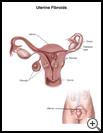
Fibroid Removal by Myomectomy
________________________________________________________________________
KEY POINTS
- Myomectomy is surgery to remove uterine fibroids, which are noncancerous growths in the uterus.
- Tell your healthcare provider about all medicines and supplements that you take. Ask your healthcare provider if you need to avoid taking any medicine or supplements before the procedure.
- Ask your healthcare how to take care of yourself at home, and when you can return to your normal activities.
________________________________________________________________________
What is a myomectomy?
Myomectomy is surgery to remove uterine fibroids. A uterine fibroid is a noncancerous growth in the uterus. It grows slowly in or from the wall of the uterus. The uterus is the muscular organ at the top of the vagina. Babies grow in the uterus, and menstrual blood comes from the uterus. Sometimes fibroids grow in the cervix. The cervix is the lower part of the uterus that opens into the vagina.
When is it used?
A uterine fibroid may be as small as a pea or as large as a grapefruit. As the fibroid grows, it may change the shape of the uterus or move it out of place. If this happens, it may cause symptoms in your bladder or intestines. Your healthcare provider may recommend this procedure to remove fibroids if you have:
- A lot of pain and blood loss during menstrual periods
- Trouble getting pregnant
- Back pain, pelvic pain, or pain during sex
- Pressure on the bladder or intestines
A myomectomy removes only the fibroids, and fibroids may come back after this procedure. A hysterectomy removes your uterus as well as fibroids, which means the fibroids will not come back, but you will not be able to get pregnant. Talk with your healthcare provider about these procedures.
How do I prepare for this procedure?
- Make plans for your care and recovery after you have the procedure. Find someone to give you a ride home after the procedure. Allow for time to rest and try to find other people to help with your day-to-day tasks while you recover.
- Follow your healthcare provider's instructions about not smoking before and after the procedure. Smokers may have more breathing problems during the procedure and heal more slowly. It is best to quit 6 to 8 weeks before surgery.
- You may or may not need to take your regular medicines the day of the procedure. Tell your healthcare provider about all medicines and supplements that you take. Some products may increase your risk of side effects. Ask your healthcare provider if you need to avoid taking any medicine or supplements before the procedure.
- Tell your healthcare provider if you have any food, medicine, or other allergies such as latex.
- Your healthcare provider will tell you when to stop eating and drinking before the procedure. This helps to keep you from vomiting during the procedure.
- Follow any other instructions your healthcare provider gives you.
- Ask any questions you have before the procedure. You should understand what your healthcare provider is going to do. You have the right to make decisions about your healthcare and to give permission for any tests or procedures.
What happens during the procedure?
The procedure will be done at the hospital. You will be given medicine called anesthesia to keep you from feeling pain. Depending on the medicine, you may be awake or asleep during the procedure. There are several ways to do a myomectomy:
- Abdominal myomectomy: Your healthcare provider will make 1 large cut in your belly. Your provider will remove the fibroids and then close the cut in your belly.
- Laparoscopic myomectomy: Your healthcare provider will make several tiny cuts in your belly and use a lighted tube with a camera called a laparoscope to help see inside the belly. Your provider will remove the fibroids and then close the cuts in your belly.
- Robotic myomectomy: Your healthcare provider will make several tiny cuts in your belly. Your provider will remove the fibroids by using a precise robot and laparoscope, and then close the cuts in your belly.
- Hysteroscopic myomectomy: Your healthcare provider will insert a lighted tube with a camera called a hysteroscope and tools through the vagina and cervix into the uterus. Your provider will remove the fibroids.
Your healthcare provider will discuss these and other surgical options with you and advise which is best for you.
What happens after the procedure?
Depending on the procedure, you may go home the same day or stay in the hospital 2 to 3 days.
You may have some pain, nausea, vomiting, or constipation after the procedure. Your healthcare provider may give you medicine or recommend other ways to treat these problems.
Ask your healthcare provider:
- How long it will take to recover
- If there are activities you should avoid, including how much weight you can lift, and when you can return to your normal activities
- How to take care of yourself at home
- What symptoms or problems you should watch for and what to do if you have them
Make sure you know when you should come back for a checkup. Keep all appointments for provider visits or tests.
What are the risks of this procedure?
Every procedure or treatment has risks. Some possible risks of this procedure include:
- You may have problems with anesthesia.
- You may have an infection, bleeding, or blood clots.
- Other parts of your body may be injured during the procedure.
- You may need a C-section in the future if you get pregnant.
- You may have scarring that causes problems getting pregnant.
Ask your healthcare provider how the risks apply to you. Be sure to discuss any other questions or concerns that you may have.

